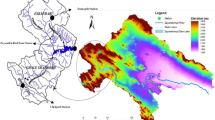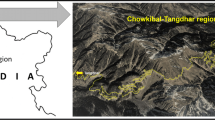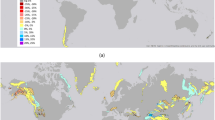Abstract
With trends indicating increase in temperature and decrease in winter precipitation, a significant negative trend in snow-covered areas has been identified in the last decade in the Himalayas. This requires a quantitative analysis of the snow cover in the higher Himalayas. In this study, a nonlinear autoregressive exogenous model, an artificial neural network (ANN), was deployed to predict the snow cover in the Kaligandaki river basin for the next 30 years. Observed climatic data, and snow covered area was used to train and test the model that captures the gross features of snow under the current climate scenario. The range of the likely effects of climate change on seasonal snow was assessed in the Himalayas using downscaled temperature and precipitation change projection from — HadCM3, a global circulation model to project future climate scenario, under the A1B emission scenario, which describes a future world of very rapid economic growth with balance use between fossil and non-fossil energy sources. The results show that there is a reduction of 9% to 46% of snow cover in different elevation zones during the considered time period, i.e., 2011 to 2040. The 4700 m to 5200 m elevation zone is the most affected area and the area higher than 5200 m is the least affected. Overall, however, it is clear from the analysis that seasonal snow in the Kaligandaki basin is likely to be subject to substantial changes due to the impact of climate change.
Similar content being viewed by others
References
ASCE Task Committee on Application of Artificial Neural Networks in Hydrology (2005) Artificial neural networks in hydrology: preliminary concepts. Journal of Hydrologic Engineering 5: 115–123.
Babel MS, Shinde VR (2010) Identifying prominent explanatory variables for water demand prediction using artificial neural networks: A case study of Bangkok. Water Resources Management 25: 1653–1676. DOI: 10.1007/s11269-010-9766-x.
Besaw LE, Rizzo DM, Bierman PR, et al. (2010) Advances in ungauged stream flow prediction using artificial neural networks. Journal of Hydrology. 386: 27–37. DOI:10.1016/j.jhydrol.2010.02.037.
Bolch T, Kulkarni A, Kääb A, et al. (2012) The state and fate of Himalayan Glaciers. Science 336: 310–314. DOI: 10.1126/science.1215828.
Cao J, Wang J, (2004) Absolute exponential stability of recurrent neural networks with Lipschitz-continuous activation functions and time delays. Neural Networks 17: 379–390. DOI:10.1016/j.neunet.2003.08.007.
Chatterjee A, Adak A, Singh AK, et al. (2010) Aerosol chemistry over a high altitude station at Northeastern Himalayas, India. PLoS ONE 5(6): e11122. DOI: 10.1371/journal.pone.0011122.
Chen C, Chen BP, Chou FN, et al. (2010) Development and application of a decision group back propagation neural network for flood forecasting. Journal of Hydrology 385: 173–182. DOI:10.1016/j.jhydrol.2010.02.019
Chen Y and Chang F (2009) Evolutionary artificial neural networks for hydrological systems forecasting. Journal of Hydrology 367: 125–137. DOI:10.1016/j.jhydrol.2009.01.009.
Connor JT, Martin RD, Atlas LE (1994) Recurrent neural networks and robust time series prediction. IEEE Transactions on Neural Networks 5(2): 240–254. DOI: 1045-9227/94.
Cooke K. (2014) Himalaya Glacial Melt Set to Peak by 2080. Available online: http://www.rtcc.org/2013/08/12/himalayaglacial-melt-set-to-peak-by-2070/ (Accessed on 10 March 2014).
Dahal N, Ojha H, et al. (2009) Impact of climate change on forests livelihoods: issues and options for Nepal, Livelihoods and Forestry Programme, 17–25.
Dery SJ, Salomonson VV, Stieglitz M, et al. (2005) Ann approach to using snow areal depletion curves inferred from MODIS and its application to land surface modelling in Alaska. Hydrological Process 19: 2755–2774. DOI: 10.1002/hyp.5784.
Decesari S, Facchini MC, Carbone C, et al. (2010) Chemical composition of PM10 and PM1 at the high-altitude Himalayan station Nepal Climate Observatory-Pyramid (NCO-P) (5079 m a.s.l.). Atmospheric Chemistry and Physics 10: 4583–4596. DOI: 10.5194/acp-10-4583-2010.
Diaconescu E (2008) The use of NARX neural networks to predict chaotic time series. Wseas Transactions on Computer Research 3(3): 182–191.
Flores BE (1986) A pragmatic view of accuracy measurement in forecasting. Omega14(2): 93–98. DOI: 10.1016/0305-0483(86)90013
Hall DK, Riggs GA, Salomonson VV (1995) Development of methods for mapping global snow cover using moderate resolution image spectro-radiometer data. Remote Sensing of Environment 54(6): 127–140. DOI: 10.1016/0034-4257(95)00137-P
Hall D K, Salomonson VV, Riggs. GA (2006) MODIS/Terra Snow Cover 8-Day L3 Global 500 m Grid. Version 5. [indicate subset used]. National Snow and Ice Data Center, Boulder, Colorado, USA.
Hantel M, Hirtl-Wielke LM (2007) Sensitivity of Alpine snow cover to European temperature. International Journal of Climatology 20: 615–640. DOI: 10.1002/joc.1472.
Hendrikx J, Hreinsoon EO (2012) The potential impact of climate change on seasonal snow in New Zealand: part II-industry vulnerability and future snow making potential. Theoretical and Applied Climatology 110:619–630. DOI: 10.1007/s00704-012-0713-z.
Huffman GJ, Adler RF, Bolvin DT, et al. (2007) The TRMM multisatellite precipitation analysis (TMP): Quasi-global, multiyear, combined sensor precipitation estimates at fine scales. Journal of Hydrometeorology 8: 38–55. DOI: 10.1175/JHM560.1.
Hung, NQ, Babel, MS, Weeskul, S, et al. (2009) An artificial neural network model for forecasting in bangkok, Thiland. Hydrology and Earth System Science 13: 1413–1425. DOI:10.5194/hess-13-1413-2009.
IPCC (2007) Climate change 2007: Impacts, Adaptation and Vulnerability. Cambridge University Press, Cambridge, UK.
Jain A, Varshney AK, Joshi UC (2001) Short term water demand forecast modelling at IIT Kanpur using artificial neural networks. Water Resources Management 22(6): 299–321. DOI:10.1023/A:1014415503476.
Karmacharya J, Shrestha A, Shrestha ML (2007) Climate change scenarios for South Asia and Central Himalayan region Based on GCM Ensemble. Department of Hydrology and Meteorology Kathmandu, Nepal.
Khadka D, Babel MS, Shrestha S and Tripathi NK (2014) Climate change impact on glacier and snow melt and runoff in Tamakoshi basin in the Hindu Kush Himalayan (HKH) region, Jornal of Hydrology 511:49–60, DOI: http://dx.doi.org/10.1016/j.jhydrol.2014.01.005.
Klein AG, Hall DK., Riggs GA (1998) Improving snow-cover mapping in forests through the use of a canopy reflectance model. Hydrological Processes 12:1723–1744. DOI: 10.1002/(SICI)1099-1085(199808/09)12:10/11〈1723::AID-HYP691〉3.0.CO;2-2.
Kulkarni AV, Bahuguna IM, Rathore BP, et al. (2007) Glacial retreat in Himalaya using Indian remote sensing satellite data. Current Science 92(1): 69–74. DOI: 10.1117/12.694004.
Li Z, Xing Q, Liu S, et al. (2012) Monitoring thickness and volume changes of the Dongkemadi Ice Field on the Qinghai-Tibetan Plateau (1969–2000) using Shuttle Radar Topography Mission and map data. International Journal of Digital Earth 5(6): 516–532 DOI: 10.1080/17538947.2011.594099.
Maier HR, Jain A, Dandy GC, et al. (2010) Methods used for the development of neural networks for prediction of water resource variables in river systems: Current status and future directions, Environmental Modelling and Software 25: 891–909. DOI:10.1016/j.envsoft.2010.02.003.
Mallapaty S, (2014) Himalayan Glaciers Debate: Melting or Growing. Available online: http://www.scidev.net/global/climate-change/feature/himalayan-glaciers-debate-meltingor-growing--1.html. (Accessed on 10 March 2014).
Maskey S, Uhlenbrook S, Ojha S (2011) An analysis of snow cover changes in the Himalayan region using MODIS snow products and in-situ temperature data. Climate Change 108: 391–400. DOI: 10.1007/s10584-011-0181-y.
Mishra B, Babel MS, Tripathi NK (2014) Analysis of climatic variability and snow cover in the Kaligandaki River Basin, Himalaya, Nepal. Theoretical and Applied Climatology 116: 681–694. DOI: 10.1007/s00704-013-0966-1.
Mishra B, Ghimire BR, Baral D, et al. (2013), Japanese Encephalitis risk zone mapping using remote sensing data: a case study of Mid and Far-Western part of Nepal. Journal of Remote Sensing 4: 47–55.
Noori R, Sabahi MS, Karbassi AR, et al. (2010) Multivariate statistical analysis of surface water quality based on correlationsand variations in the data set. Desalination 260: 129–136. DOI:10.1016/j.desal.2010.04.053.
Nourani V, Hosseini BA, Daneshvar VF, et al. (2012) Classification of groundwater level data using SOM to develop ANN-based forecasting model. International Journal of Soft Computing and Engineering 2(1): 464–469.
Pope VD, Gallani ML, Rowntree PR, et al. (2000) The impact of new physical parameterizations in the Hadley Centre climate model — HadAM3. Climate Dynamics 16(2–3): 123–146. DOI:10.1007/s003820050009
Quiroga VM, Mano A, Asaoka Y, et al. (2013), Snow glacier melt estimation in tropical and an glaciers using artificial neutral network. Hydrology and Earth System Sciences 17: 1265–1280. DOI:10.5194/hessd-9-9455-2012.
Rees HG, Collins DN (2006) Regional differences in response of flow in glacierfid Himalayan rivers to climatic warming. Hydrological Process 20: 2157–2169. DOI: 10.1002/hyp.6209.
Riggs GA, Hall DK, Salomonson VV (2006) MODIS snow products user guide to collection 5. NSID C1-80.
Sauter T, Schneider C, Kilian R, et al. (2009) Simulation and analysis of Runoff from a partly glaciated meso-scale catchment area in Patagonia using an artificial neural network. Hydrological Processes 23: 1019–1030. DOI: 10.1002/hyp.7210.
Sauter T, Weitzenkamp B, Schneider C (2010) Spatio-temporal prediction of snow cover in the black forest mountain range using remote sensing and a recurrent neural network. International Journal of Climatology 30: 2330–2341. DOI:10.1002/joc.2043.
Kronenberg R, Barfus K, Franke J, et al. (2013) On the downscaling of meteorological fields using recurrent networks for modelling the water balance in a meso-scale catchment area of Saxony, Germany. Atmospheric and Climate Sciences 3(4): 552–561. DOI: 10.4236/acs.2013.34058 P
Shen HY, Chang LC (2013) Online multistep-ahead inundation depth forecasts by recurrent NARX networks. Hydrology and Earth System Sciences 17: 935–945. DOI: 10.5194/hess-17-935-2013.
Stres B, Philippot L, Faganeli J, et al. (2010) Frequent freezethaw cycles yield diminished yet resistant and responsive microbial communities in two temperate soils: a laboratory experiment. FEMS Microbiology Ecology 74(2): 323–35. DOI: 10.1111/j.1574-6941.2010.00951.x.
Stres B, Sul WJ, Murovec B, et al. (2013) Recently deglaciated high-altitude Soils of the Himalaya: diverse environments, heterogenous bacterial communities and long-range dust inputs from the upper troposphere. PLoS ONE 8(9): e76440. DOI: 10.1371/journal.pone.0076440
Siegelmann HT, Horne BG, Giles CL (1997) Computational capabilities of recurrent NARX neural networks. IEEE Transactions on Systems, Man, and Cybernetics 27(2): 208–215. DOI: 10.1109/3477.558801
Welsh W (2008) Water balance modeling in brown, Queensland, and the ten iterative steps in model developmentand evaluation. Environmental Modelling and Software 23: 195–205. DOI:10.1016/j.envsoft.2007.05.014
Wang K, Wan Z, Wang P, et al. (2007) Evaluation and improvement of the MODIS land surface temperature/emissivity products using ground-based measurements at a semi-desert site on the western Tibetan Plateau. International Journal of Remote Sensing 28: 2549–2565. DOI: 10.1080/01431160600702665
Wang W, Liang S, Meyers T (2008) Validating MODIS land surface temperature products using long-term night time ground measurements. Remote Sensing of Environment 112: 623–635. DOI:10.1016/j.rse.2007.05.024
Xu J, Grumbine RE, Shrestha A, et al. (2009) The melting Himalayas: cascading effects of climate change on water, biodiversity, and livelihoods. Conservation Biology 23(3): 520–530. DOI: 10.1111/j.1523-1739.2009.01237.x
Author information
Authors and Affiliations
Corresponding author
Rights and permissions
About this article
Cite this article
Mishra, B., Tripathi, N.K. & Babel, M.S. An artificial neural network-based snow cover predictive modeling in the higher Himalayas. J. Mt. Sci. 11, 825–837 (2014). https://doi.org/10.1007/s11629-014-2985-5
Received:
Accepted:
Published:
Issue Date:
DOI: https://doi.org/10.1007/s11629-014-2985-5




